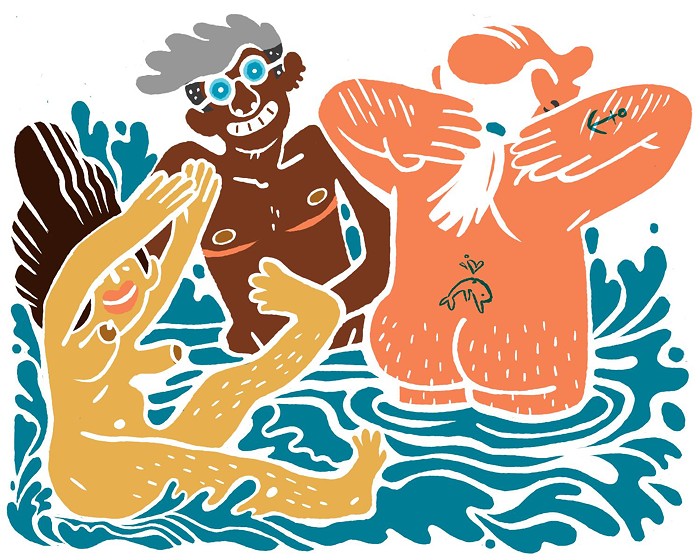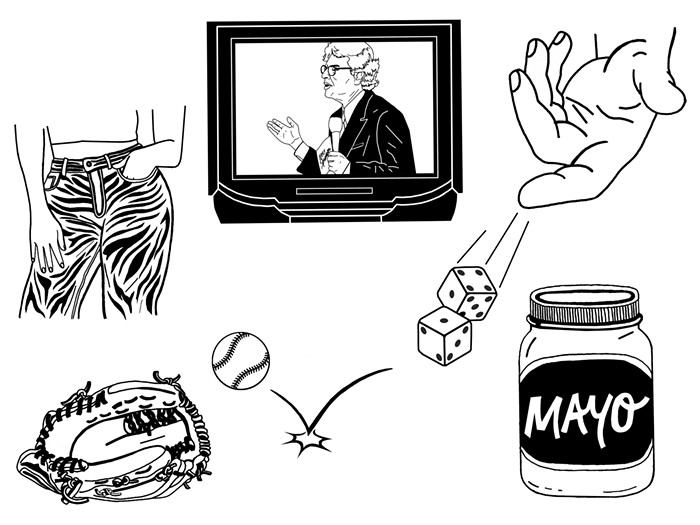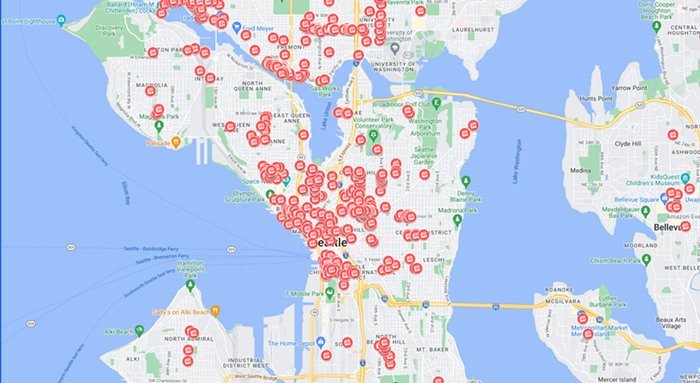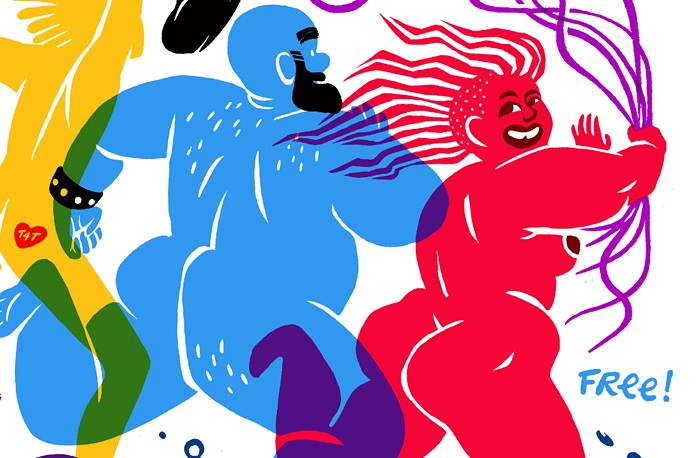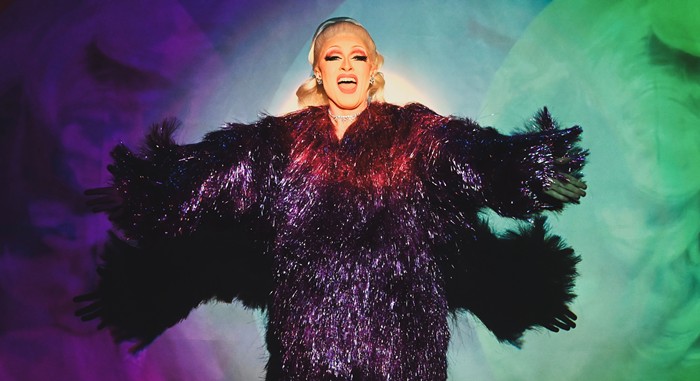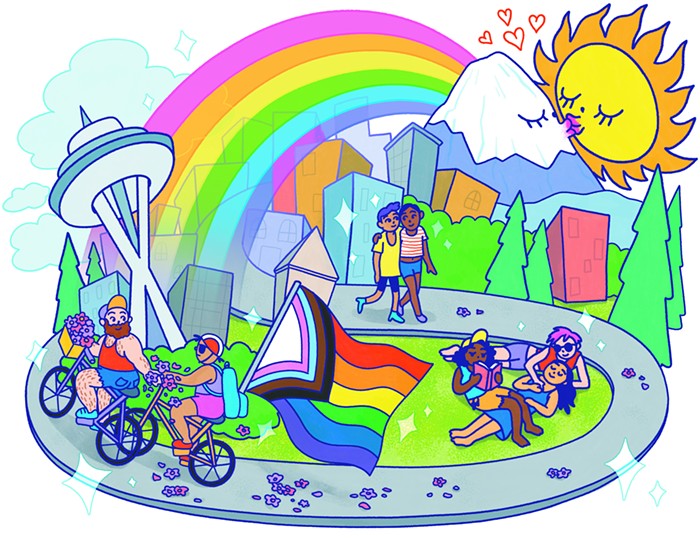The Books of Love
Charlie’s Queer Books Is a Welcoming Space for Seattle’s LGBTQ+ Lit Nerds
The Future of HIV Treatment Is Injectable
Promising Drugs Could Expand Treatment–If We Get Out of Our Own Way
What’s Next for Denny Blaine?
Maybe New Rules, but Certainly Fewer Thorns
Getting High with Seattle Cheer
A Very Queer Play Date
Dave Upthegrove Wants to Save the Trees
...And Become Washington State’s First Gay Executive While He’s at It
Queer Issue 2024 Pickup Locations
Looking for a Copy of This Year’s Queer Issue? You Can Find One at the Following Locations.
Can Seattle Drag Afford to Stay Weird?
Rising Costs, and Fewer Beginner-Friendly Venues, Are Sanitizing Seattle’s Drag Scene
50 Years of Queers
Gay Betrayals! Rich Prudes! Queer Futures! And an Absolutely Stuffed Pride Calendar!
The Gays Who Slayed and the Gays Who Betrayed
Not Every Queer Politician Is an “Ally”
Letters to Our Younger Trans Selves
What We Wish We Knew
The Reality Behind the Story I Told The Stranger
I Said I Was Detrans, but Really I Was Struggling
Out of This World
Forming the SassyBlack Universe
The Futures of Seattle’s Gayborhood
An Architect, an Urban Planner, a Documentarian, an Academic, and a Business Owner Imagine What Capitol Hill Will Look Like in 50 Years
The Biggest Pride Month 2024 Events in Seattle
Festivals, Parties, and More All Throughout June
Seattle’s gayborhood, located on Capitol Hill spiritually if increasingly less so demographically, certainly isn’t what it used to be in the early 2010s, which wasn’t what it used to be in the early ‘00s, which definitely wasn’t what it used to be in the ‘90s, or the ‘80s, or the ‘70s. And before that, the gayborhood wasn’t even on Capitol Hill! It was in Pioneer Square. And how dare we forget about the lesbians of the University District in the ‘70s–we’d never, and we won’t start now!
The point is that big gay cities like ours change, and so do their gayborhoods. Rather than dwell on its past for the 50th anniversary of Seattle Pride, this year I wanted help envisioning its future. So I asked five bright brains with connections to the neighborhood to look into their crystal balls. Please allow me to introduce them.
Andrew Grant Houston is an architect and urban designer who runs House Cosmopolitan, an innovative architecture and design firm. Joey Burgess runs many of the Hill’s growing and foundational institutions, including The Cuff Complex, Queer/Bar, Grims, and Elliott Bay Book Company. Among many other things, Cynthia Brothers founded Vanishing Seattle, a media project that documents the city’s fading cultural institutions. Manish Chalana is an associate professor in the University of Washington’s Urban Design and Planning department. Yes Segura founded Smash the Box, an urban planning and design firm.
The Seattle Times reports that the LGBTQ+ population of Seattle is dropping but still pretty strong–do you think Capitol Hill will still be seen as the gayborhood in 2074? If not, where do you think the next one will be?
Andrew Grant Houston: Yes, unless by an act of God we all become rich and join the rest of the homo homeowners who are building up some cool communities in the South End and White Center. Symbolically, Capitol Hill will always be the gayborhood, but if we want to ensure the neighborhood stays queer in truth and not just in name, then we need to provide more housing options for people in all walks of life—especially those who are a part of our nightlife community. The dual-income dog daddies and the badass enby bartenders both deserve to live here in housing that works for their lifestyles and budgets.
Joey Burgess: I think the Hill will forever be the queer bedrock of Seattle. In a perfect Seattle, though, every neighborhood would have queer bars. Imagine a bunch of queer waterholes becoming as common as your neighborhood corner store–that would be a dreamy future.
Cynthia Brothers: As much as I would love for Capitol Hill to retain a strong, unapologetically queer character, based on the way things have been going I think there’s a huge risk that queer residents, businesses, and cultural and subversive spaces could be displaced to cater to more hetero, mainstream, and economically dominant tastes by 50 years or much earlier … unless there’s some political and financial interventions from City leaders to supplement the efforts of the LGBTQ+ community to maintain their presence. Rainbow crosswalks may last 50 years, but if queer culture isn’t embedded in the neighborhood anymore, they’ll be more a memorial than an affirmation.
Manish Chalana: Seattle’s gayborhood has shifted from Pioneer Square to Denny Triangle and then to Capitol Hill, so another move isn’t out of the question. However, Capitol Hill now feels deeply established. While multiple queer districts are likely to emerge (as they already are), Capitol Hill will remain the mothership.
Yes Segura: Give me a second as I scream this into the void: RENT SHOULD NOT BE THIS HIGH! Looking at how America has treated queer landmarks like Stonewall … No, I don’t think Capitol Hill will be the queerborhood then. But, at the same time, I like to think that by then everyone will realize that they are queer.
Do you think the Hill will still serve as the center of the city’s nightlife in 50 years? Which venues, shops, and restaurants do you think will still be around?
AGH: I hope we’re not! Yes, gay clubs play great music, but I’d love to see some more clubs across Seattle because density for housing is great but for dancefloors it is not. As for other spaces, what I hope will be around here again is a big gay coffee shop. Losing both Gaybucks (I know) and Kaladi means we don’t have a larger community gathering space the way we used to.
JB: Out of all the businesses on the Hill ... I hope to see The Wildrose open, alive, and thriving when I’m 91. I hope that my husband and I can take our 54 and 52-year-old daughters to Taco Tuesday and play some Indigo Girls on a vinyl jukebox. Maybe after we can head over to Elliott Bay Books and toast to its 100-year anniversary? Fingers crossed.
CB: I think as long as Capitol Hill continues to attract a mix of younger folks, bars, restaurants, and businesses, then it will be a nightlife “hot spot”—for better or worse. The question is what that nightlife will look like, and who it is for. It’s wild to think that Neumos is one of a very small handful of live music venues left in an area once teeming with clubs and musicians (so I’m guessing Neumos, as a heavy-hitter, will still be around). I’d be happy to see longtime legendary places like Wildrose, Pony, Neighbours, The Eagle, Club Z, Harry’s Bar, The Crescent Lounge, Madison Pub, The Mercury, City Market, CC’s, Century Ballroom, Trendy Wendy, Elliott Bay, and DeLuxe still around. Plus, it’s heartening to see new clubs like Massive resurface/reclaim space (RIP R Place). Also, more gloryholes, please. A Seattle without gloryholes is certainly not one I want to live in.
MC: Yes, mostly, but other neighborhoods will continue to become “more gay.” West Seattle and White Center will be in full competition by then. I mostly hang out in Diesel and CC’s, so I hope they’ll still be around. But honestly, I bet it’ll be Club Z—that place seems like it could survive Armageddon!
YS: For sure the Hill will be the center of nightlife in 50 years–as long as it continues with the density of its restaurants, bars, and its Arts District. Honestly I would like for all of these places to still be up, though what the neighborhood needs is more local Queer Transgender + BIPOC-owned spaces. PERIOD.
Do you think the housing will be denser, or abandoned, or pretty much look the same as it does now?
AGH: Definitely denser. I expect a high-rise tower or two next to the current light-rail station, though hopefully in less monochrome motifs. I’d also love to see a balance of building heights and public space akin to another global gayborhood, Le Marais. There, public cruising–aka walking around at all hours of the day and night–is prioritized over space for cars.
JB: Hopefully much denser, with residential and commercial rent control in place.
CB: I’d guess denser; doesn’t seem like it’s been slowing down in the last 20 years.
MC: Denser, probably; affordable, probably not. Sure, US cities experienced a big population decline once, as they went through deindustrialization and suburbanization. But my money is safe betting on a city like Seattle to keep on growing in the long term. And if the city’s growing, then the inner core is growing in all but the weirdest of times. And who knows—by then maybe there’ll even be a second light rail station in Capitol Hill.
YS: How we assess the value of property needs to be dismantled. I’ll leave it at that.
Do you think Pike/Pine will ever become pedestrianized, like a Barcelona-style superblock? Do you think it should be?
AGH: Yes and yes. One motto to keep in mind in Seattle is “never say never:” whether by organizing or a fluke, some changes in the city happen when you least expect. Funnily enough, as part of the comprehensive plan the City has to create a subarea plan for Capitol Hill/First Hill, which will be an opportunity in the next year to push for the superblock to happen.
JB: In a dreamworld this would be heavenly. I believe a new generation of leadership in local politics might be up for this challenge one day in the not-so-distant future.
CB: I can see urban planners here trying to jump on that. Hopefully not implementing them in a way that would exacerbate gentrification and already stark income divides, which is one of the criticisms of superblocks.
MC: Not Barcelona-style superblock morphology per se, but Pike/Pine’s emerging urban form could strive to embrace principles of superblock planning, emphasizing livability shaped not just by density, safety, and walkability, but also by equity and social justice.
YS: We should pedestrianize Pike/Pine, but we should also pedestrianize the same Cap Hill pocket areas that temporarily close off streets for events. For example, On the Block: 2nd Saturdays closes off 11th Avenue and E. Pike Street/E. Pine Street. CLOSE IT OFF. Capitol Hill Pride closes off Broadway from Roy to John. CLOSE IT OFF. There are many more examples in the neighborhood. This outdated mindset that we must have cars on every street is one that is draconian and degrades society’s health. Other countries have figured it out, why can’t we?
Today I still occasionally see the jester skipping through the streets, the colorful wizard on walks, and Mohammad walking the streets selling his bundle of roses. What sort of characters do you imagine on the streets of Capitol Hill in 2074?
AGH: These three are icons, so it’s hard to guess, but our next characters will also be unique. I could imagine a bear furry that sells smoked salmon, a daylight drag queen doing impromptu numbers on street corners, or someone moonwalking up Broadway in a spacesuit. In short, they’ll be queer and out of this world.
JB: I imagine Bosco will be occasionally spotted in the corridor looking forever young and forever gorgeous, living by the words of Lisle Von Rhuman, “This is life’s ultimate cruelty. It offers us a taste of youth and vitality, and then it makes us witness our own decay.”
CB: I love the Skipping Jestress and Mohammed! Those sightings make me happy. In 2074 Capitol Hill, there might be some kooky “characters” that are actually AI-generated hologram personas reciting the classifieds of The Stranger issues from the 1990s. But if it was a hologram of Slats, Mama Tits, or Lady Krishna, I could get into it.
MC: Crazy fringe people who dare to explore the urban fabric in front of them instead of keeping their cerebrally implanted iPhone 669s on all of the time. Someone without any tattoos? Community robots in rainbow underwear doubling as traffic police?
YS: I imagine by then we will have flying cars that will help us crusty elder millennials to be out and about. Those free-spirited characters will both be in their flying cars and down on earth being themselves. For real though, where are our flying cars?!


